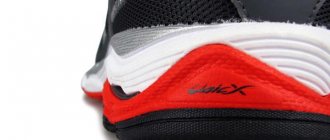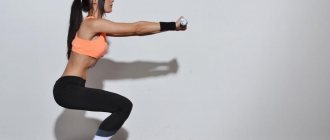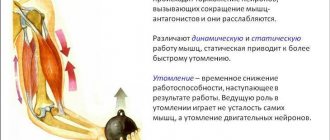Leg exercises make them beautiful and toned. The aesthetic side of this issue and health, which undoubtedly improves during the period of active physical activity on these parts of the body, are an obvious incentive for appropriate training. Moreover, their implementation is not limited exclusively to the gym. You can get slender, strong legs at home. To achieve such a result, it is not necessary to have special equipment and devices. So if you don’t have the desire or ability to visit gyms, work out at home.
Nutrition for weight loss legs
As already mentioned, 70% of slim legs depends on nutrition. If you need to lose weight very quickly, you can use a special diet to “dry” the body, which involves following a strict diet. Athletes mainly resort to such a diet when they need to create abs on their stomachs and gain definition in their muscles. In other cases, it is enough to adhere to a proper and balanced diet. This is enough to get rid of extra pounds, make your legs thin, without losing the smooth lines of the female figure.
We have already discussed how to eat properly to lose weight in this article. Here are just the basic rules that you need to follow for quick, effective weight loss.
Basic rules for losing weight on legs and thighs
1. Drinking enough water per day . Water is the main component of all living things; life-giving moisture is found even in our bones. A long-term lack of water leads to disruption of metabolic processes, as a result, fats are broken down worse and the process of losing weight slows down. At the same time, unlimited fluid intake leads to swelling and makes even thin legs look full.
Therefore, stick to the norm of 1.5-2 liters per day. If you lead an active lifestyle, you can increase this amount to 2.5 liters.
2. Eating leafy vegetables and greens . These plant products cleanse the intestines of waste and toxins, saturate the body with useful substances, and regulate appetite due to their fiber content. Leafy vegetables and greens have a negative calorie content, that is, the body spends more energy on their absorption than it receives. Thus, metabolism accelerates and fat is broken down more quickly.
The foods with the highest negative calorie content are: celery, fennel, basil, spinach, and lettuce. The daily portion for weight loss is up to 500 grams of greens, which is best divided into two doses - lunch and dinner.
3. Avoid fried and fatty foods . Frying food in oil adds extra calories. To be precise, this is 9 kcal for every gram of fat that the products absorbed from the oil during the frying process. As a result, 100 grams of the finished product absorbs an average of 2 grams of fat.
Moreover, with this method of preparation, products lose most of their nutrients. Therefore, boil, stew, bake in the oven or on the grill.
4. Reduce salt intake . The daily norm is 15 grams, and up to 10 grams of salt is initially contained in many products: meat, fish, bread, cereals, etc. Thus, adding salt to food should take 5 grams per day - that’s 1 teaspoon. Excess salt retains water in the body, leads to swelling, especially in the legs, and slows down the process of losing weight.
If the food seems bland, add natural seasonings - thyme, basil, oregano, suneli hops.
5. Elimination of mayonnaise, sauces and other dressings . These high-calorie foods are made with refined vegetable oil. They have a lot of calories and do not have a single beneficial component. Even one tablespoon of mayonnaise can ruin your weight loss efforts.
In addition, sauces and mayonnaise contain a lot of salt, usually several times higher than the norm.
6. Eating fiber . Dietary fiber, also known as fiber, coats the walls of the stomach, thereby reducing appetite and prolonging the feeling of fullness. It does not contain vitamins or other nutrients, but it removes waste and toxins from the body, prevents the development of many diseases, and also improves digestion, thereby helping to lose weight faster.
Bran has a record amount of fiber . It is also found in many vegetables, fruits, legumes, and whole grains.
7. Eating lean protein . Give up sausages, sausages and other industrially produced meat products, replacing them with complete sources of protein. These are eggs, cheese, cottage cheese, fish, seafood, poultry, beef.
You should eat at least 100 g of pure protein per day. For example, 1 egg contains 13 grams of protein, fish and lean meat - about 25 grams.
8. Eating slow carbohydrates . Slow carbohydrates, unlike fast carbohydrates, gradually supply the body with energy and are not immediately stored as fat if they are not spent on time.
These include: rice (preferably brown), buckwheat, oats, durum wheat pasta, whole grain bread. Moreover, most of the carbohydrates are consumed in the first half of the day.
9. Eating the right fats . These include omega, mono- and polyunsaturated fats. The main sources of healthy fats are nuts, seeds, avocados, olive and flaxseed oil, egg yolk, and fatty fish. The consumption of saturated fats (butter, high-fat dairy products, fatty meats) should be kept to a minimum, and trans fats should be completely eliminated, as it has been proven that this type of fat can remain in the body for years.
Therefore, if you want to make your legs thin, then forever give up fast food, chips, instant products, store-bought baked goods, since they are mainly made from margarine, as well as light cheeses in which animal fats are replaced with transgenic ones.
10. Replace unhealthy sweets with healthy ones . We all understand that it is impossible to refuse various “goodies”. Therefore, to minimize the harm of sweets, simply replace them with healthy ones.
These include: honey, dried fruits, dark chocolate, marmalade, marshmallows, marshmallows, halva, kozinaki, fitness bars.
11. Watch your calorie intake and diet . Eat at the same time 4-5 times a day. The amount of calories must be kept from 1800 to 2000 kcal. If you need to make your legs thin, you may need to reduce your calorie intake by 200-300 calories.
By adhering to these rules, you will soon see that the process of losing weight has begun and even the legs and hips - the most difficult areas to lose weight - have noticeably decreased in volume.
Cardio for losing weight in legs
Aerobic exercise speeds up your metabolism and triggers the fat burning process. Exercising strengthens muscles, making your legs not just thin, but slender and toned.
Thus, proper nutrition plus cardio will give excellent results.
Keep in mind: Cardio training without smart nutrition is a ticking time bomb. If you don't learn to control your eating, then training will increase your appetite even more.
The optimal number of classes is 3-5 times a week, for 45-60 minutes. There is no point in exercising for less than 40 minutes, since the process of burning fat begins only after all energy sources have been exhausted. This point occurs after about 30 minutes of continuous activity. If you do cardio in the morning and on an empty stomach, the process of fat breakdown begins almost from the very beginning of the workout.
Types of cardio that directly involve the legs:
jogging or high-intensity interval running; jumping rope; ice skating and skiing; walking on a stair simulator or regular walking for weight loss; stepper, elliptical trainer, exercise bike.
You should not exercise too intensely; fat burning occurs better with moderate activity .
Also, interval training shows good results in terms of weight loss - when training with a low degree of activity alternates with a high one. Although the latter option may cause an increase in muscle mass.
Strength training for slimming legs
It is believed that cardio is the best type of training for weight loss, and strength training is more suitable for increasing and defining muscle mass. It doesn't really matter whether you run or do strength training, what matters is that your muscles are working and burning calories. Moreover, strength training, unlike cardio, speeds up your metabolism and forces your body to burn fat even after you leave the gym. This type of training will make your legs thin and toned, and not at all unpumped, as many people think .
To build muscle, you need to lift heavy weights and, accordingly, eat a large amount of proteins and carbohydrates, exceeding the norm by 20-30%. Although, if you initially have large muscle mass that responds to any load, strength exercises can make your legs even bigger. But more on that later.
Different types of exercises are aimed at strengthening specific muscle groups, for example, you can tighten sagging arms, strengthen your legs and “lift” your buttocks. At the same time, the skin will not sag, as often happens after rapid weight loss. This is another benefit of strength training .
Depending on the problem, namely the “problem” area of your legs, you need to choose the right exercises. The legs can be divided into the following zones:
buttocks; "breeches" zone; hips; inner thigh; shin.
If the problem area is the buttocks and the “breeches” area, then the most effective exercises for losing weight and strengthening this area are squats, gluteal bridges, and walking on the buttocks. We discussed exercises for the buttocks in more detail in this article.
If most of the fat mass is concentrated in the thigh area, then you should pay attention to exercises for losing weight in the legs. These are lunges, moving the leg to the side and back, swings, as well as special exercises from ballet.
For many girls, the problem area is the inner thigh. This is because the muscles in this area never work, even when walking. To keep your legs toned and slender, pay attention to plie squats, lying leg raises, swings lying on your side, and the butterfly exercise. We wrote in more detail about how to strengthen the inner thigh in this article.
The hips and riding breeches are not the most problematic area. Fat deposits and full calves are much more difficult to correct. They can remain large even when the legs have become completely thin. This suggests that perhaps the calves have good muscle mass that easily responds to exercise. Running and exercise will not only not help in this case, but will also aggravate the situation. The load should be one in which the muscles are involved, but not overloaded for their own growth. This is where simple stretching will come to the rescue. To make your calves thin , choose exercises from yoga, Pilates and stretching. This type of training makes them more fit and elongated.
For those who want to get lean legs without building muscle mass, it is recommended to do at least 15 repetitions in each approach, and preferably 20-25. The weight needs to be selected so that you feel tired during the last repetitions.
If you need to lose weight quickly, then at least 2 times a week you need to do cardio and the same amount of strength exercises. Always stretch at the end of your workout.
Basic ways to quickly relieve tired legs
The following techniques can increase tone and relieve discomfort and swelling:
- Regular exercises and short gymnastics - rolling a ball with your feet, taking off your shoes to rest - during breaks between work will help improve blood flow. It is necessary to temporarily give your legs an elevated position. The outflow of blood will ease the discomfort.
- Choosing the right shoes. You need breathable, natural material and a comfortable insole. You will also have to give up heels, but a completely flat sole will not relieve the tension. It is recommended to wear orthopedic shoes with low heels or wedges.
- Increasing activity and walking.
- Application of ointments:
- Warming agents increase blood flow to the muscles. Suitable for athletes and people with heavy physical activity on the lower limbs. The ointment is applied before training or work to prevent pain and sprains.
Stretching for thin and slender legs
Stretching or stretching exercises make the muscles more elongated and the legs visually thinner and slimmer. Therefore, every time after strength training, spend 5-10 minutes on the following stretches:
1. Stand straight, bend one leg at the knee and pull it back by the toe. You should feel a stretch in the front thigh muscle. Do the same on the other leg.
2. While on your knees, extend one leg forward. Grasp the toe of your other foot with your hand and pull it towards you. Change position and repeat the exercise.
3. To stretch your hamstrings, stand straight with one leg extended forward and the other slightly bent. Stretch your body forward, you should feel the biceps of the thigh (back of the thigh) stretch.
4. You can make your calves thinner by regularly doing exercises to stretch your calf muscles. To do this, sit on the floor, stretch your legs, grab your socks with your hands and pull them towards you.
5. A similar exercise, but from a standing position. Stand facing the wall, lean on your hands. Lunge forward with one leg, while the other remains in place fully straightened. Feet are on the floor. Stretch forward until you stretch the calf muscles of your back leg.
6. The butterfly exercise will help tighten the inner thigh muscles. Sit on the floor, bend your knees, press your heels towards you. Do a few swings. For greater stretching, you can press on your knees with your hands.
7. Now straighten your knees and spread them as far as possible to the side. Lean forward and you will feel the inner thigh stretch.
We looked at every type of training that can be used to make your legs thin and slender. All that remains is to choose the most suitable option.
Choosing a weight loss strategy
The result, how much weight you lose in your legs, will depend on your body type. The fact is that some girls’ thighs consist largely of fat mass, while others have muscle mass, which may not be visible due to the superficial layer of fat. Therefore, the method of losing weight will be different in each case.
How to determine your hip type:
straighten your leg; tense your muscles; Grab the skin with the top layer of fat with your fingers.
If the fold is large, then your fat mass predominates; if it is thin, then you have developed muscles with a small percentage of fat.
Let's consider the further sequence of weight loss for each case.
If you have muscular thighs , then avoid any strength training, as well as high-intensity interval cardio. Moderate cardio training is recommended for your hip type. This includes long-distance jogging, swimming, and regular walking (except for walking uphill and climbing stairs). With such training, muscles do not have the opportunity to grow, but fat mass is burned well.
When exercising on exercise machines, the load should be light and the incline low, otherwise your legs may become even larger.
If you have fat thighs , that is, the fold turned out to be quite large when measured, then add strength training to your cardio training. This comprehensive approach will allow you to quickly get rid of fat mass, as well as make your legs slimmer.
Causes of leg pain
This symptom can be provoked by various groups of factors:
- Sedentary lifestyle: at work, in transport, at home. The load on the legs decreases significantly, and muscle tone decreases. But as soon as you have to walk longer than usual, your legs begin to “hum.”
- Standing work places unnecessary stress on the legs, leading to pain and swelling in the ankles.
- Excess weight also has a negative impact not only on the condition of the body, but also on the legs. The percentage of fat exceeds the amount of muscle, and the frame of the limbs cannot withstand the overload.
- Constantly wearing socks, stockings or tights. They compress the veins, which leads to blood stagnation and lack of nutrients. The solution in this case can be special therapeutic socks that restore proper blood circulation.
- Chronic diseases usually develop due to insufficient care, but if a person already suffers from varicose veins or a problem with the joints and spine, then the legs will hurt more often.
- Disorders in the vascular system: blood vessels narrow and blood flow to muscle tissue decreases, which causes phlebitis - inflammation of the vein walls. Many factors lead to such disorders, but they are more often observed in smokers, hypertensive patients and people who have had a heart attack or stroke.
- Inflammatory processes in the joints and tissues of the legs, injuries.
Additional products for thin and slender legs
So that during the process of losing weight, the skin does not sag, but remains taut, you need to take care of it. Creams with a lifting effect, drainage and anti-cellulite wraps, and massage will come to the rescue here. All these remedies also help to make your legs thin and slender. But all this works together with proper nutrition.
Hot wraps are considered the most effective , which can be performed both in the salon and at home. The effect of wraps is achieved not by getting rid of fat mass, but by drainage (removing excess fluid from tissues), which also adds a lot of centimeters. Wraps also work well against cellulite and sagging skin. There are many recipes for leg wraps for weight loss; the essence of this procedure is discussed in more detail in this article.
That’s basically all you need to know if you’re planning to make your legs thin and slender. There are only three rules: balanced nutrition, sports and skin care. You don't have to completely change your lifestyle to do this. Just stop using the elevator, walk to work, get active for any reason. After all, every step will bring you closer to your dream.
How and when to do self-massage
Place a golf ball (or any other ball) on the floor, place your foot on it and begin to gently roll the ball forward, backward and sideways with your foot. Increase pressure on the ball, avoiding pain. Roll the ball for 30-60 seconds with each foot.
On the surface of the foot there are many nerve endings that begin to work only when we try to understand what we have stepped on there. For this reason, rolling a ball stimulates the nervous system. This self-massage of the feet is best used in the morning immediately after waking up and during warm-up.











